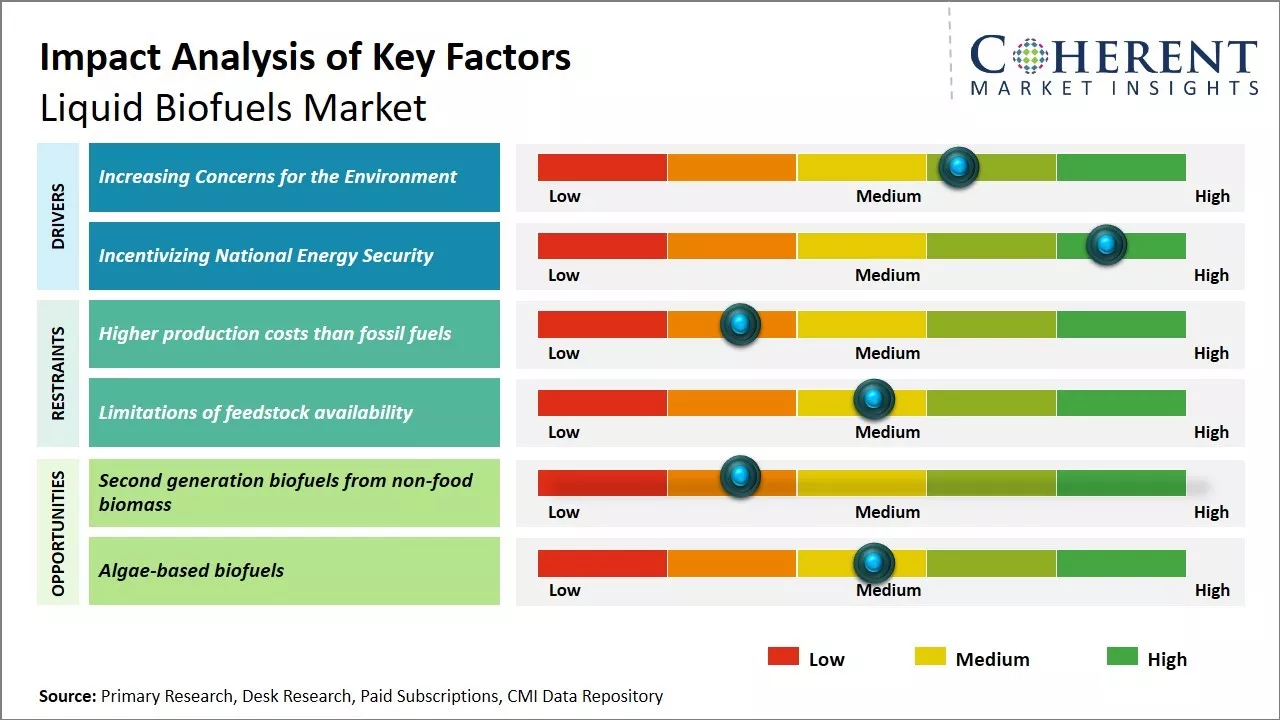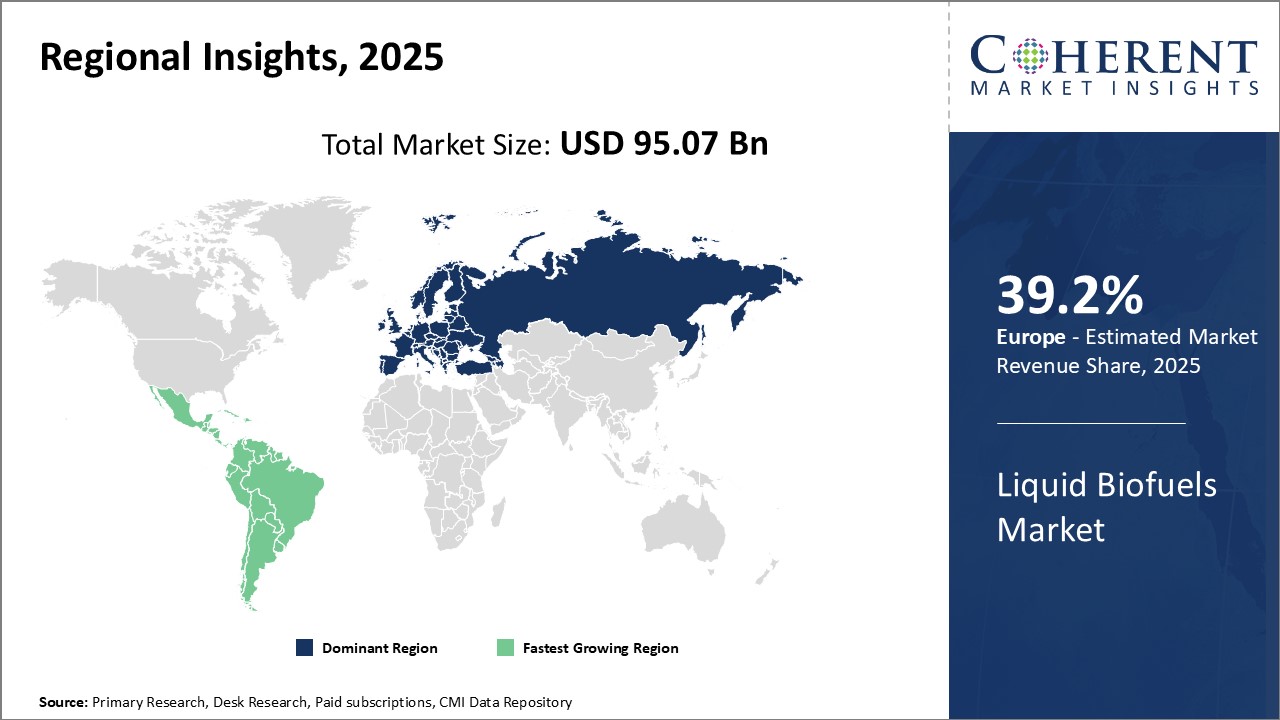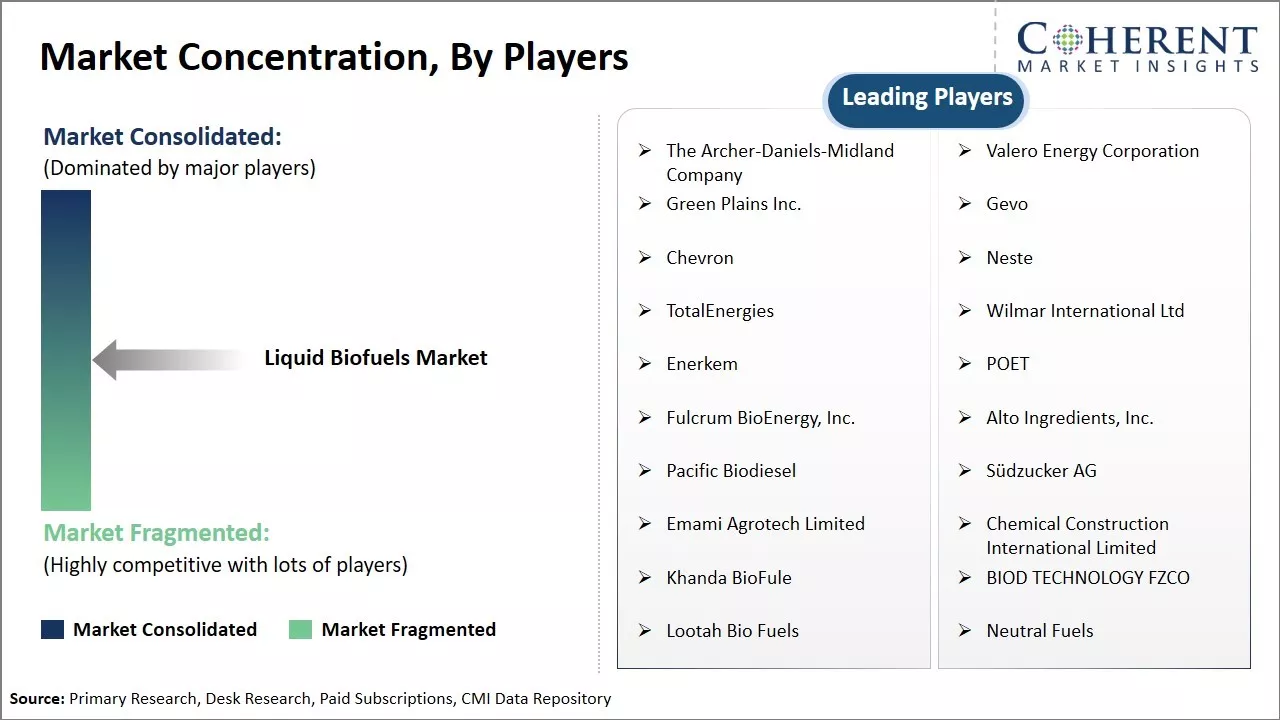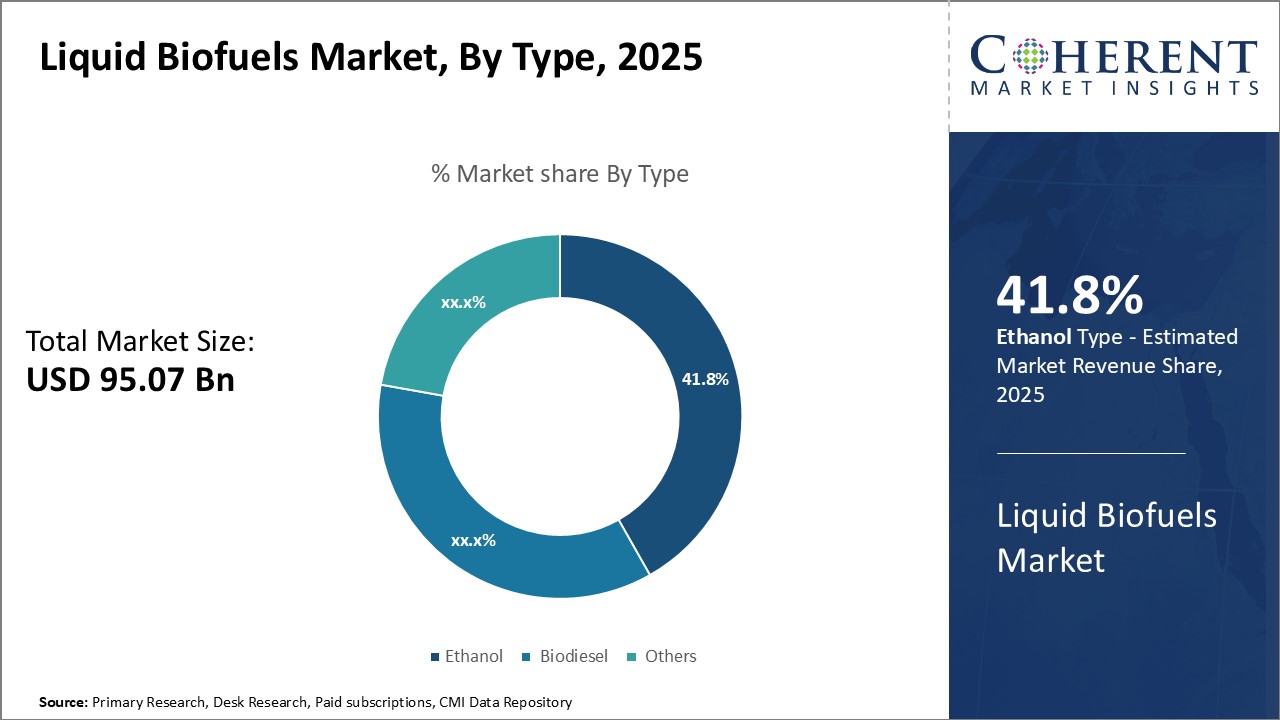Liquid Biofuels Market Size and Share Analysis - Growth Trends and Forecasts (2025-2032)
The liquid biofuels market is estimated to be valued at USD 95.07 Bn in 2025 and is expected to reach USD 148.82 Bn by 2032, growing at a compound annual growth rate (CAGR) of 6.6% from 2025 to 2032.
Key Takeaways
- Based on Type, Ethanol segment is expected to account for 41.8% of the market share in 2025, due to its renewable and versatile fuel source.
- Based on Feedstock, Sugarcane segment is projected to hold a 34% market share in 2025, attributed to its fermentable sugar source, making ethanol production efficient and cost-effective.
- Based on Process, Fermentation segment is anticipated to capture 34% of the market share in 2025, supported by is ability to allow microorganisms to convert feedstock into biofuel.
- Based on Application, the Transportation Fuel segment is anticipated to capture the highest share in 2025, supported by widespread adoption of biodiesel and bioethanol.
- Based on Region, Europe is projected to lead the market with a 39.2% share in 2025, driven by strong EU policies promoting biofuel uses. While, Latin America is set to be the fastest growing regio in the forecast period, supported by strong agro-industrial based and abundant natural resources.

To learn more about this report, Download Free Sample
Market Overview
Liquid biofuel is a renewable fuel derived from biological feedstocks. It is processes into liquid form for the use in transportation, industrial, and power generation application. It includes bioethanol, biodiesel, hydrotreated vegetable oil (HVO), and advanced biofuels. With rising environmental concerns and stringent regulations promoting the usage of clean fuels, the demand for liquid biofuels is increasing steadily worldwide. Several governments are also offering incentives and subsidies for the production and usage of liquid biofuels to reduce dependency on fossil fuels.
Current Events and their Impact on the Photodynamic Therapy Market
|
Current Events |
Description and their Impact |
|
Regulatory Policy Shifts |
|
|
Feedstock Market Dynamics |
|
Uncover macros and micros vetted on 75+ parameters: Get instant access to report
Role of Artificial Intelligence (AI) in Liquid Biofuel Market
Integration of Artificial Intelligence (AI) in Liquid Biofuels is transforming the force across the biofuel value chain from feedstock optimization and process efficiency to supply chain logistics and emissions forecasting. AI is improving the economics of biofuel production by enabling real-time, data-driven decisions on feedstock types, quantities, and sourcing. AI has the potential to efficiently strategize infrastructure for upgrading the liquid biofuel industry under hard climate, feedstock scarcity and policy complexities. AI helps in maintaining competitiveness and demonstrate low-carbon credibility when feedstock prices rise and lifecycle scrutiny intensifies.
For instance, U.S. DOE-funded research at NREL and LBNL integrated AI for feedstock pretreatment analysis and microbial strain optimization in advanced ethanol production.
Liquid Biofuel Market Insights, By Type- Global Policy Push Towards Renewable Fuels Drives the Ethanol Segment Growth
In terms of type, ethanol is expected to contribute 41.8% share of the market in 2025, owing to the global policy push towards renewable fuel adoption. Ethanol is one of the most widely used renewable fuels today, finding applications in gasoline fuel blends and as a general biofuel. Many countries have formulated policies that mandate the blending of gasoline with certain percentages of ethanol. This policy thrust stems from the environmental benefits of ethanol compared to conventional transportation fuels. As a biofuel, the production and combustion of ethanol results in a net reduction of greenhouse gas emissions. The feedstock for ethanol is also more sustainable than crude oil. With growing concerns around climate change and energy security, many governments are incentivizing the use of lower-carbon biofuels like ethanol through mechanisms like the Renewable Fuel Standard. Leading ethanol producers like the U.S., Brazil, and EU countries have ramped up their annual ethanol production capacities and blend mandates significantly over the past decade due to these policies.
In April 2025, Praj Industries organized a technical workshop in Pune to explore the progress of ethanol blending in India and identify new opportunities in the biofuels sector. This is further positively influencing the liquid biofuels market share.
Liquid Biofuel Market Insights, By Feedstock- Sugarcane- Low input and land costs drives the sugarcane dominance in feedstock
In terms of feedstock, sugarcane is expected to contribute 34% share of the market in 2025, owing to its competitive advantages in terms of low input and land costs for cultivation. Sugarcane has the highest yield of fermentable sugar per unit area compared to other starch and sugar-bearing crops. With annual yields ranging from 50-80 tons per hectare, sugarcane produces significantly more fermentable sugar than corn or soy. Additionally, sugarcane cultivation requires modest irrigation and agrochemical requirements. Water needs for sugarcane are lower than field crops like corn. Likewise, its tropical and subtropical cultivation zones have fewer pest and disease problems compared to temperate grain belts. This translates to lower variable input costs for sugarcane farmers.
In March 2025, Wärtsilä, collaborated with Brazilian energy company Energetica Suape II S.A, to conduct a world’s first clean energy trial which will see ethanol, a biofuel mainly produced from sugar used to generate clean power. Brazil is the largest producer and user of ethanol from sugarcane.
Liquid Biofuel Market Insights, By Process- Fermentation- Advanced biotechnology drives fermentation dominance in process
In terms of process, fermentation is expected to contribute 34% share of the market in 2025, owing to advanced biotechnological capabilities that enhance yields and lower production costs. Fermentation utilizes microbial action to convert the fermentable sugars present in biofuel feedstock into alcohol. Contemporary fermentation technologies deploy specialized yeasts and enzymes that have been optimized through genetic engineering for high performance. Modern fermentation facilities employ pure cultures of genetically enhanced Saccharomyces yeasts tailored for specific feedstock like sugarcane or corn. These "designer yeasts" have been re-engineered to achieve some of the highest ethanol yields biologically possible from available sugars. Simultaneously, fermentation processes leverage high-density cell cultures and finely-tuned nutrient environments to maximize yeast growth rates and titers. Recent bioprocess innovations also focus on developing hyper-productive strains of yeasts and other microbes that can ferment cellulosic sugars. This expands the range of viable lower-cost feedstock beyond sugars to agricultural residues. When coupled with advanced pre-treatment technologies, cellulosic fermentation promises further reductions in ethanol costs. Owing to substantial biotechnological advancements over the past decades, fermentation has emerged as the most economically competitive industrial process for converting biomass into liquid biofuels at scale.
In March 2025, fermentation process used for the production of biofuel was creating toxic to the microbes that produce it. Now Researchers from the University of Cincinnati and the U.S. Department of Energy’s Oak Ridge National Laboratory achieved a breakthrough in understanding the vulnerability of microbes to the alcohols they produce during fermentation of plant biomass.
Liquid Biofuel Market Insights, By Application- Transportation fuel- Widespread adoption of biodiesel and bioethanol
The transportation fuel segment is accounted to lead the market with highest share in 2025. The primary factor driving transportation fuel is the widespread adoption of biodiesel and bioethanol in road transports due to their renewable nature, ability to reduce reliance on fossil fuel and potential for lower greenhouse gas emission compared to traditional fuels. As transportation sector contributes to great greenhouse gas emissions, adoption of biofuel is essential to limit the production of harmful gases. Biofuels are produces from biomass which offers reduction in greenhouse gas emission. According to the U.S. Environmental Protection Agency, from transportation alone, roughly 28% of total U.S. GHG emission is contributed, globally it is 20% of all carbon dioxide emission.
Regional Insights

To learn more about this report, Download Free Sample
Europe Liquid Biofuel Market Analysis and Trends
The European Union remains the dominant player in the global liquid biofuels market, maintaining the largest market share over the past decade. The market is expected to account for 39.2% of the market share in 2025. Stringent environmental regulations promoting the use of renewable fuels for transportation have driven significant demand within the EU. All member states have adopted mandatory blending targets and incentives for producers and consumers. Popular fuels like biodiesel and bioethanol find widespread use in vehicles across the region due to supportive policies. Germany, France, and Italy account for over half of the EU's liquid biofuel consumption owing to their large vehicle fleets and emphasis on developing sustainable alternatives to petroleum. Also, in April 2025, Dutch biofuel provider FincoEnergies joined the FuelEU Maritime compliance market with a new pooling scheme. This initiative will offer discounts to clients fueling with its biofuels and allow 'compliance surpluses' generated by these vessels to be shared with ships that are not in compliance. This is further expected to proliferate the liquid biofuel market share in Europe.
Latin America Liquid Biofuel Market Analysis and Trends
Latin America has emerged as the fastest growing market for liquid biofuels internationally. The region has a combination of favorable climatic conditions and government incentives that have spurred major investments in sustainable fuel production from sugarcane and soybean feedstock. Brazil remains the dominant producer globally, with its sugarcane-based ethanol widely blended into gasoline. However, other countries like Argentina and Colombia are rapidly scaling up their exports of biodiesel and ethanol to capitalize on the growing demand. Strong production bases catering to international demand have given Latin America an edge over other developing regions in terms of scaling biofuel industries. This leadership position is expected to foster further technology transfers and partnerships that can drive future market expansion.
India Liquid Biofuel Market Analysis and Trends
The Indian government has taken a steps to support the ethanol blending programme, aiming to reduce the country’s dependence on imported fossil fuels and promote cleaner alternatives. To accelerate ethanol production, financial incentives have been facilitated for setting up ethanol manufacturing units, particularly for existing sugar mills. These facilities are encouraged to diversify their feedstock base, utilizing not only sugarcane but also damaged food grains and cereals such as maize. Along with that, cooperative sugar mills that supply ethanol to Oil Marketing Companies (OMCs) are eligible for interest subsidies, further boosting participation. These measures collectively support the government’s target of achieving higher ethanol blending rates.
Global Liquid Biofuel Market Trends
Change Toward Advanced and Drop-In Biofuels
There is a rapid growth from first-generation (food-based) biofuels toward second- and third-generation alternatives derived from non-food feedstocks (e.g., waste oils, agricultural residues, lignocellulosic biomass, and algae). The incorporation of Hydrotreated vegetable oil (HVO) and renewable diesel are gaining demand due to their compatibility with existing diesel infrastructure and ability to achieve up to 90% GHG reduction than fossil diesel. Along with that, Biojet fuel (SAF – Sustainable Aviation Fuel) is becoming a key focus, especially in the EU and U.S., supported by orders such as the EU RefuelEU Aviation Regulation and the U.S. SAF Grand Challenge targeting 3 billion gallons by 2030.
Policy Driven Market Expansion
In the U.S., the Renewable Fuel Standard (RFS) and state-level Low Carbon Fuel Standards (e.g., California LCFS) are incentivizing higher combinations of renewable fuels, while the Inflation Reduction Act (IRA) offers tax credits for low-carbon fuels, including Clean Fuel Production Credit (45Z) effective from 2025. The EU’s RED III directive has made it compulsory to use 42% renewable energy in transport by 2030, with strictness on food-based biofuels and a boost for advanced alternatives. Asia-Pacific nations, including India, China, and Indonesia, are grading up ethanol blending to reduce oil dependency and support rural bio economies.
Global Liquid Biofuel Market Drivers
Increasing Concerns for the Environment
As climate change concerns continue to rise globally, the need for more sustainable fuel sources has become increasingly imperative. Liquid biofuels provide an attractive alternative to conventional fossil fuels due to their lower carbon footprint over their lifecycle. While all sources of energy have some environmental impact, biofuels can help reduce dependence on non-renewable oil reserves when produced responsibly through sustainable practices. According to the U.S. Energy Information Administration, biofuels are seen as more environmentally friendly than fossil fuels and can reduce reliance on imported petroleum, benefiting national economy and security, which is further positively influencing the liquid biofuel market forecast.
Incentivizing National Energy Security
Energy security remains a key priority for many nations seeking to hedge risks from fluctuating and potentially vulnerable international oil supply chains. Liquid biofuels derived from domestically sourced feedstock offer a strategic alternative that can boost self-reliance and insulate fuel needs from geopolitical uncertainties in oil markets. Supportive biofuel blending mandates and producer incentives from governments aim to increase the local economic viability and scale-up of renewable fuel sectors. The Indian government has introduced several schemes to support the biofuel sector, emphasizing the role of subsidies in facilitating this transition. One key initiative is the Pradhan Mantri JI-VAN Yojana (2019), which aims to create a favorable environment for commercial projects and boost research and development in the second-generation (2G) ethanol sector. By encouraging the establishment of biofuel plants, the scheme seeks to drive innovation in biofuel technologies, helping to advance the country’s biofuel production capabilities and sustainability goals. This is further accelerating the liquid biofuels market growth.
Global Liquid Biofuel Market Restraints
Higher production costs than fossil fuels
The production of liquid biofuels from biomass requires large capital expenditure on setting up processing facilities as well as continued operating expenses. The biomass feedstock itself has a higher cost than fossil fuels like crude oil or natural gas. Producing biofuels also involves multi-step processing of the biomass which includes pre-treatment, enzymatic/chemical hydrolysis of cellulose and hemicellulose into fermentable sugars, fermentation of sugars into alcohols and separation and purification. All these steps are energy intensive and add to the overall costs. Furthermore, the yields of biofuels obtained from biomass are generally lower than from fossil fuels.
Global Liquid Biofuel Market Opportunity
Second generation biofuels from non-food biomass
Second generation biofuels from non-food biomass have the potential to be a major opportunity in the liquid biofuels market going forward. Unlike first generation biofuels which use corn, sugarcane, or vegetable oils for fuel production, second generation biofuels are produced from non-edible plant matter such as agricultural residue, municipal solid waste, or purpose grown energy crops. These are more sustainable and environment friendly compared to the first-generation biofuels which were often criticized for diversions of agricultural lands for fuel crops. This is impacting the global food supply and inflation in food prices. The use of lignocellulosic biomass which includes crop residues, wood wastes, and purpose grown energy crops like switchgrass for fuel production offers multiple advantages. It does not compromise on food security as non-edible plant parts are used. According to the U.S. Department of Energy, nearly a billion tons of renewable biomass is potentially available annually in the U.S. from agricultural and forest residues alone without impacting food, feed, and traditional product demands. Conversion technologies are also improving to efficiently break down the lignocellulose components of plant cell walls into simple sugars for fermentation into alcohols like ethanol. Several companies are actively working to commercialize these technologies through demonstration plants.
Market Report Scope
Liquid Biofuels Market Report Coverage
| Report Coverage | Details | ||
|---|---|---|---|
| Base Year: | 2024 | Market Size in 2025: | USD 95.07 Bn |
| Historical Data for: | 2020 To 2024 | Forecast Period: | 2025 To 2032 |
| Forecast Period 2025 to 2032 CAGR: | 6.6% | 2032 Value Projection: | USD 148.82 Bn |
| Geographies covered: |
|
||
| Segments covered: |
|
||
| Companies covered: |
The Archer-Daniels-Midland Company, Valero Energy Corporation, Green Plains Inc., Gevo, Chevron, Neste, TotalEnergies, Wilmar International Ltd, Enerkem, POET, Fulcrum BioEnergy, Inc., Alto Ingredients, Inc., Pacific Biodiesel, Südzucker AG, Emami Agrotech Limited, Chemical Construction International Limited, Khanda BioFule, BIOD TECHNOLOGY FZCO, Lootah Bio Fuels, and Neutral Fuels |
||
| Growth Drivers: |
|
||
| Restraints & Challenges: |
|
||
Uncover macros and micros vetted on 75+ parameters: Get instant access to report
Market Concentration and Competitive Landscape

To learn more about this report, Download Free Sample
Key Development
- In April 2025, Madhya Pradesh, India launched Biofuel initiative focusing on advancing biofuels, offering financial incentives and promoting a circular economy. The aim is to reduce fossil fuel dependence and enhance rural livelihoods. This scheme is running under Madhya Pradesh Renewable Energy Policy, 2025.
- In January 2025, Berge Bulk & BHP joined forces and launched iron ore voyages from Autralia to China using 100% biodiesel. BHP made this collaboration with Berge Bulk to reduce greenhouse gas emissions from shipping of our products. B100 biodiesel uses vegetable oil, animal fat, tallow and/or waste cooking oil from restaurants and industrial kitchens and translates to an almost 84% reduction in well-to-wake greenhouse gas (GHG).
- In June 2024, the Food and Agriculture Organization of the United Nations (FAO) has launched FAOSTAT domain on bioenergy. This initiative expands FAO’s provision of global data on agrifood systems. Theis new statistics provide information n the production and final consumption of bioenergy by type of biofuel: solid biofuels (animal waste, bagasse, black liquor, charcoal, fuelwood, other vegetal material and residues); liquid biofuels (bio jet kerosene, biodiesel, biogasoline, other liquid biofuels), and gaseous biofuels (biogas).
- In September 2023, Prime Minister, Narendra Modi launched the Global Biofuels Alliance (GBA) at the G20 Summit in New Delhi, India. The GBA is a collaboration between 19 countries and 12 international organizations, including G20 members and non-member countries.
Analyst Opinion (Expert Opinion)
- Baylor University’s Swirl Burst Injector enables efficient combustion of glycerol, a biodiesel byproduct, transforming waste into a usable energy source. This innovation improves bio-refinery circularity and boosts profitability by 20–30%, particularly in facilities seeking cost-effective alternatives to traditional waste management.
- In addition to this, Nano-catalyst adoption in biomass conversion enhances transesterification reactions, cutting down processing time and energy requirements. This can lower biodiesel production costs by 15–25%, offering substantial benefits to small and regional producers operating under tighter margins.
- The EU’s anti-dumping measures on Chinese biodiesel have redirected approximately $420 million in trade to Southeast Asian producers. This shift is reconfiguring global biodiesel supply chains and opening new investment avenues in alternative production hubs across Asia.
- U.S.-Mexico corn ethanol export agreements have unlocked a 650 million gallon per year market for U.S. producers, providing a critical outlet amid domestic policy uncertainty. The deals reinforce cross-border energy trade and reduce the U.S. ethanol sector’s reliance on internal market dynamics.
- The delayed enforcement of the EU Deforestation Regulation (EUDR) provides short-term operational flexibility to palm oil-based biodiesel producers. However, it also increases projected compliance costs by 8–12% in 2026, pushing companies to accelerate investment in traceable and deforestation-free supply chains.
- California’s LCFS credit price volatility has created significant earnings risk for renewable diesel plants. Fluctuations over a 30-day period can alter profit margins by 9–15%, forcing producers to adopt hedging mechanisms or adjust production strategies to maintain financial stability.
Market Segmentation
- Type Insights (Revenue, USD Bn, 2020 - 2032)
- Ethanol
- Biodiesel
- Others (Hydrotreated vegetable oil, etc.)
- Feedstock Insights (Revenue, USD Bn, 2020 - 2032)
- Corn
- Sugarcane
- Soybean
- Canola
- Others (Cellulosic biomass, etc.)
- Process Insights (Revenue, USD Bn, 2020 - 2032)
- Fermentation
- Transesterification
- Others (Hydro Heating, etc.)
- Application Insights (Revenue, USD Bn, 2020 - 2032)
- Transportation Fuel
- Marine
- Others (Aviation, etc.)
- Power Generation
- Others (Thermal Heating, etc.)
- Regional Insights (Revenue, USD Bn, 2020 - 2032)
- North America
- U.S.
- Canada
- Latin America
- Brazil
- Argentina
- Mexico
- Rest of Latin America
- Europe
- Germany
- U.K.
- Spain
- France
- Italy
- Russia
- Rest of Europe
- Asia Pacific
- China
- India
- Japan
- Australia
- South Korea
- ASEAN
- Rest of Asia Pacific
- Middle East & Africa
- GCC Countries
- Israel
- Rest of Middle East & Africa
- Key Players Insights
-
- The Archer-Daniels-Midland Company
- Valero Energy Corporation
- Green Plains Inc.
- Gevo
- Chevron
- Neste
- TotalEnergies
- Wilmar International Ltd
- Enerkem
- POET
- Fulcrum BioEnergy, Inc.
- Alto Ingredients, Inc.
- Pacific Biodiesel
- Südzucker AG
- Emami Agrotech Limited
- Chemical Construction International Limited
- Khanda BioFule
- BIOD TECHNOLOGY FZCO
- Lootah Bio Fuels
- Neutral Fuels
Sources:
Primary Research Interviews from the following stakeholders:
Stakeholders:
- Interviews with chemical engineers, agronomists, refinery operators, energy policy analysts, and sustainability officers specializing in renewable fuels and biomass-to-liquid conversion technologies.
Specific stakeholders:
- Heads of bioenergy divisions at national energy labs (e.g., National Renewable Energy Laboratory [NREL], Argonne National Laboratory)
- Biorefinery operators and project leads at advanced biofuel production facilities
- Ethanol and biodiesel plant managers (e.g., POET, REG, Neste U.S. operations)
- Feedstock supply chain managers (e.g., for used cooking oil, lignocellulosic biomass)
- Policy advisors at DOE Bioenergy Technologies Office and USDA BioPreferred Program
- Decarbonization officers at commercial aviation and marine fuel purchasers
- Researchers working on algae, waste-to-fuel, and synthetic biology-based fuels
Databases:
- U.S. Department of Energy’s Alternative Fuels Data Center (AFDC)
- U.S. Energy Information Administration (EIA) – Biofuels data and reports
- European Commission – Energy and Transport Statistics
- IEA Bioenergy Task Reports
- FAOSTAT – Bioenergy Feedstock Data
- International Renewable Energy Agency (IRENA) Statistics
- U.S. EPA Renewable Fuel Standard (RFS) Compliance Data
Magazines:
- Biofuels International
- Ethanol Producer Magazine
- Biodiesel Magazine
- CleanTechnica – Biofuels Section
- GreenBiz – Renewable Energy and Circular Economy Features
Journals:
- Biofuels, Bioproducts and Biorefining (Wiley)
- Bioresource Technology (Elsevier)
- Renewable & Sustainable Energy Reviews
- Fuel Processing Technology
- Energy Policy
- Journal of Cleaner Production
- Biotechnology for Biofuels and Bioproducts
Newspapers:
- The New York Times – Climate and Energy Section
- Financial Times – Energy Markets and Transition Reports
- The Guardian – Green Energy and Environment Coverage
- Reuters – Renewable Energy and Biofuels News
- Politico – Agriculture & Energy Policy Coverage
Associations:
- American Society of Agricultural and Biological Engineers (ASABE)
- Biomass Thermal Energy Council (BTEC)
- Advanced Biofuels Association (ABA)
- European Biodiesel Board (EBB)
- International Air Transport Association (IATA) – SAF Task Force
- Renewable Fuels Association (RFA)
- National Biodiesel Board (Clean Fuels Alliance America)
Public Domain Sources:
- U.S. Department of Energy (DOE)
- Environmental Protection Agency (EPA) – Renewable Fuel Standard Program
- United Nations Food and Agriculture Organization (FAO)
- U.S. Department of Agriculture (USDA) – BioPreferred Program
- International Energy Agency (IEA) – Bioenergy Division
- European Commission – Directorate-General for Energy
- National Renewable Energy Laboratory (NREL)
Proprietary Elements:
- CMI Data Analytics Tool, and Proprietary CMI Existing Repository of information for last 8 years
*Definition: The liquid biofuels market involves the production and sale of liquid fuels derived from biomass or other renewable sources. This includes bioethanol, biodiesel, pyrolysis oils, biomethanol, and bio-butanol. These renewable fuels serve as alternatives to petroleum-based gasoline, diesel, and jet fuel and help reduce dependence on fossil fuels and greenhouse gas emissions from the transportation sector.
Share
Share
Missing comfort of reading report in your local language? Find your preferred language :
Transform your Strategy with Exclusive Trending Reports :
Frequently Asked Questions
EXISTING CLIENTELE
Joining thousands of companies around the world committed to making the Excellent Business Solutions.
View All Our Clients

